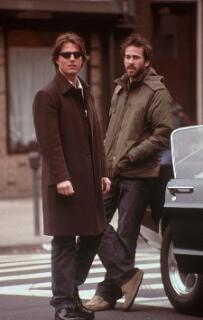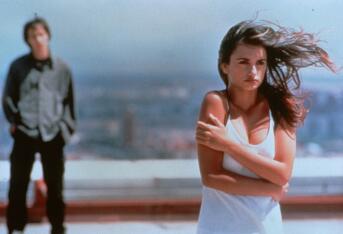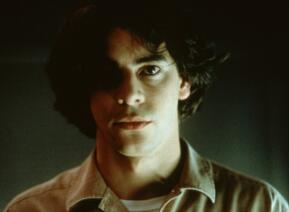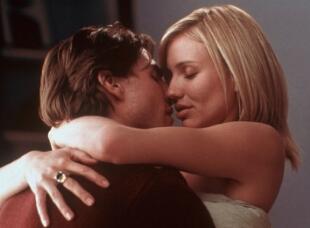Abre Those Eyes: The Americanization of Abre Los Ojos and the Hispanization of Vanilla Sky
by Joseph Palis
The truth lies not in one dream but in many.
--Arabian Nights
It is difficult to do a remake of a film because people are wont to compare the two films and almost always diss the new version (Warren Beatty's Love Affair, despite the appearance of Katharine Hepburn since On Golden Pond and Ennio Morricone's haunting score, will always be rated lower than 1939's Love Affair and 1957's An Affair To Remember). However misguided that may be, it is true that it is tough to top the former's obvious qualities and at the same time make the new version resonate and be made relevant to the current tastes of the current generation. There were remakes that shouldn't have been allowed (look at the pathetic frame-by-frame remake of Alfred Hitchcock's Psycho by Gus Van Sant; hopefully, Van Sant will find his métier again to come up with classics as brilliant as 1989's Drugstore Cowboy). At the same time, there are films that need a new lease in life by way of a fresher remake taking full advantage of the current technology.
Cameron Crowe's Vanilla Sky is a remake of Alejandro Amenabar's Abre Los Ojos. Amenabar (who you probably remember as the director of the Nicole Kidman film The Others) directed Abre Los Ojos (Open Your Eyes) in 1997. Both films showed us how American and European filmmakers approach the subject matter and imbue each frame with their region's distinct flavor.
The two films' similar story introduces us to a young, ambitious, a tad promiscuous, confident charmer (David Aames in Vanilla Sky; Cesar in Abre Los Ojos) whose famously bohemian ways were legendary among people close to him. He beds any woman he fancies and is savvy enough not to be seen twice with any of them. He hasn't yet fully extricated himself from his current flame (Julie and Nuria in the American and Spanish versions, respectively) when he suddenly felt weak-kneed upon seeing the dramatic beauty of the mysterious Sofia (played beguilingly by the lovely Penelope Cruz in both versions). Sofia, however, is pursued by David's/Cesar's best friend (Brian and Pelayo in the Crowe and Amenabar films, respectively) and it took David some time before he finally ensnared her. While their relationship blossoms, something tragic happened that forever changed David/Cesar's destiny: a car accident that disfigured his face and killed its driver: Julie/Nuria.
At this point, this is where the two films really started to grow complicated and Jungian and went their specific ways telling the rest of the story by conjuring visual and aural images unique to Spanish and American sensibilities.
It is hard to comment on the film without giving away the major twists of the story but the more interesting aspect of comparing the two films is the difference in the directorial approaches of these two disparate filmmakers and the resulting images onscreen.
 Crowe's version was a bit muddled, which is surprising because his deft hand was most evident in Jerry Maguire and Almost Famous (maybe because, unlike Vanilla Sky, he wrote the screenplays for both films?). His storytelling approach was mired by florid juxtapositions of pop cultural images to make us, the filmgoers, witness the wealth and rich detail of David's past life. Although some of his touches were more clever than Amenabar's (recognition of extraordinary paintings that ranged from Impressionist master Claude Monet to extraordinary singer-songwriter-painter Joni Mitchell was tastefully esoteric), Crowe's version is more confusing because of the many visual detours it took to tell its story. The film loses a foothold or two in presenting the waking and the dreaming states of David. While the images are David Lynch-weird, it fails to give you that feeling of strangeness that makes Lynch's movies eerie and compelling. There were no severed ear and hideous elephant men. In the film's denouement, you understand less why he chose one option over the other, given the frenetic pace and the usual bombardment of pop culture images.
Crowe's version was a bit muddled, which is surprising because his deft hand was most evident in Jerry Maguire and Almost Famous (maybe because, unlike Vanilla Sky, he wrote the screenplays for both films?). His storytelling approach was mired by florid juxtapositions of pop cultural images to make us, the filmgoers, witness the wealth and rich detail of David's past life. Although some of his touches were more clever than Amenabar's (recognition of extraordinary paintings that ranged from Impressionist master Claude Monet to extraordinary singer-songwriter-painter Joni Mitchell was tastefully esoteric), Crowe's version is more confusing because of the many visual detours it took to tell its story. The film loses a foothold or two in presenting the waking and the dreaming states of David. While the images are David Lynch-weird, it fails to give you that feeling of strangeness that makes Lynch's movies eerie and compelling. There were no severed ear and hideous elephant men. In the film's denouement, you understand less why he chose one option over the other, given the frenetic pace and the usual bombardment of pop culture images.
One factor for this confusion (on my part, maybe) was because I watched Vanilla Sky weeks before Abre Los Ojos. I understand that Vanilla Sky warrants a second informed look to fully grasp the nuances of the story's circuitious turns, but while I was watching it, I was fidgeting in my seat because I was slowly losing track with what Crowe was trying to convey.
Except for two major instances, Vanilla Sky followed Amenabar's story shot-by-shot including Cruise's famous sprint along a deserted urban center (in this case, Times Square in New York with nary a soul in sight). Crowe embellished his version with formulaic and tried-and-tested devices meant to heighten the tension (the rooftop scene in the film's denouement was expansive and Kafkaesque, while Amenabar's version of the same scene opted for a more low-key presentation, but manages, just the same to give a constricting, nightmare-like feeling of claustrophobia). Big budget also made a big difference where principal photography (head shots, filming the dreamscapes) was concerned and Vanilla Sky obviously one-ups the Spanish version in this department. However, the overall feel of the Spanish version, though less menacing, is disturbingly real despite (or maybe BECAUSE of) the minimal use of special effects.
 Amenabar's version creates confusion but it manages to seamlessly put it back in order to make its point clearer. Abre Los Ojos is less majestic but it successfully achieves a level of authenticity through economies of scale. It manages to do away with excessive (and sometimes unnecessary) references to pop cultural icons, and did a better job delineating reality from dreams, while sustaining the moviegoer's interest. Maybe the best way to look at the two films more objectively is to consider the Spanish version as a standard melody, which gave Vanilla Sky the opportunity to improvise to dazzling effect.
Amenabar's version creates confusion but it manages to seamlessly put it back in order to make its point clearer. Abre Los Ojos is less majestic but it successfully achieves a level of authenticity through economies of scale. It manages to do away with excessive (and sometimes unnecessary) references to pop cultural icons, and did a better job delineating reality from dreams, while sustaining the moviegoer's interest. Maybe the best way to look at the two films more objectively is to consider the Spanish version as a standard melody, which gave Vanilla Sky the opportunity to improvise to dazzling effect.
 Eduardo Noriega as Cesar had none of Cruise's flashy smiles, but he comes out more authentic, real and ultimately more convincing. His rages seem to serve as objective correlative to the confusion of his world; his inability to understand the irreconcilability of dream and reality mirrors the film audience's own confusion and bewilderment. Noriega (who was also in Amenabar's 1996 Goya-winning film Thesis) is less self-conscious and comes out more credible as a guy who may not really be matinee-idol handsome, but who obviously knows he can be lovable and irresistible to women by way of his rakish but surprisingly childlike ways (he is Jean Paul Belmondo to Cruise's Clark Gable). Even when wearing masks, the expression in his eyes palpably conveys a tragedy too overwhelming to be articulated.
Eduardo Noriega as Cesar had none of Cruise's flashy smiles, but he comes out more authentic, real and ultimately more convincing. His rages seem to serve as objective correlative to the confusion of his world; his inability to understand the irreconcilability of dream and reality mirrors the film audience's own confusion and bewilderment. Noriega (who was also in Amenabar's 1996 Goya-winning film Thesis) is less self-conscious and comes out more credible as a guy who may not really be matinee-idol handsome, but who obviously knows he can be lovable and irresistible to women by way of his rakish but surprisingly childlike ways (he is Jean Paul Belmondo to Cruise's Clark Gable). Even when wearing masks, the expression in his eyes palpably conveys a tragedy too overwhelming to be articulated.
It is grossly unfair to thrash Tom Cruise's performance in this film just because he is a larger-than-life force in Hollywood. To his credit, he is not miscast and one could see how he worked hard to give credibility and justice to the role of David. But he obviously worked way too hard such that he sometimes smothered the very essence of David. To express his pre-accident character's slightly-bohemian, slightly-ingénue attributes, he either smiles a lot or look bewildered. While he is creditably intense, his irritating mannerism of widening his eyes to show great shock irritates rather than enlightens. But you have to respect this actor for subjecting his face to all levels of ugliness to get to the heart of the character and for having a keen sense for edgier materials like these. During his screen time in the film, I thought he was at his most fragile, affecting and quietly effective when he wears masks. That way, you focus more on his character and the story he tells.
Penelope Cruz, as Sofia in both films, was incredible. In the Spanish version she was very pretty in an unpolished way and appeared less inhibited. In one scene (which differed from the American film), she was magical as a mime artist performing in the park while David was looking at her adoringly. In the Crowe version, she was more sophisticated though exoticized - her foreignness was made apparent by her undeniable Spanish lilt and the obvious difficulty in pronouncing English words. However, she had an advantage of knowing her character's subtleties by this time. While her Sofia in Amenabar's version was girl-next-door ingenue, in the Crowe version, she comes across as a confident career woman who knows her priorities in life.
Nuria was played by Najwa Nimri (who resembles The Crying Game-era Miranda Richardson) and was very heartbreakingly effective. The role of Nuria calls for an actress with versatility and Nimri rose to the challenge with a minimum of acting tics. In fact, I consider Nuria's role as more challenging than Sofia's and a more tragic figure this side of Desdemona. Nimri's pain was so acutely realized most especially in Cesar's party: she didn't need to scream to let you know she is in obvious pain.
 But the greatest surprise was Cameron Diaz's more polished reinterpretation. As Julie Gianni, Diaz recalls the proud but flawed heroines of Tennessee Williams. In that same party, Julie looks so downright pathetic ("the loneliest woman on earth holding a martini") and nakedly real it uncomfortably makes one remember the most lasting and hurtful event in one's life. Her next scene was even more heartbreaking because we see her dancing with a waiter long before the party's over to convey her intense hunger for affection. The role suits Cameron Diaz perfectly. Her previous roles were either naively kooky (There's Something About Mary), or naively sweet (My Best Friend's Wedding) or naively devious (Very Bad Things). In Vanilla Sky, she held her own and her performance recalls her acting high point: Spike Jonze's Being John Malkovich.
But the greatest surprise was Cameron Diaz's more polished reinterpretation. As Julie Gianni, Diaz recalls the proud but flawed heroines of Tennessee Williams. In that same party, Julie looks so downright pathetic ("the loneliest woman on earth holding a martini") and nakedly real it uncomfortably makes one remember the most lasting and hurtful event in one's life. Her next scene was even more heartbreaking because we see her dancing with a waiter long before the party's over to convey her intense hunger for affection. The role suits Cameron Diaz perfectly. Her previous roles were either naively kooky (There's Something About Mary), or naively sweet (My Best Friend's Wedding) or naively devious (Very Bad Things). In Vanilla Sky, she held her own and her performance recalls her acting high point: Spike Jonze's Being John Malkovich.
Fele Martinez plays Pelayo--Cesar's best friend, while Jason Lee essayed the same role (as Brian Shelby, this time). Martinez's Pelayo has this less-than-average looks that makes him credible as a slightly jealous/envious best friend to Cesar. His plainness was a way to show you how well he understood his status as the exalted sidekick in relation to his friend's Lothario.
In Vanilla Sky, the cameos were awesome! Timothy Spall (Secrets & Lies, Topsy-Turvy) was unrecognizable as David's knowing friend, although his role was non-existent in Amenabar's film. Noah Taylor (Shine) was appropriately New Age-y and slightly effeminate for a crucial role he plays in the film. Lastly, Tilda Swinton (Orlando, The Beach and The Deep End) was like Cate Blanchett as Galadriel in Lord of the Rings: a scenery chewer. In her only scene in the movie, she was able to authoritatively explain to David the essence of an alternative life. Her androgynous face was in perfect sync with the genderless persona she is portraying. If only for the able support of these actors, Vanilla Sky is a must-watch.
However, it was in Abre Los Ojos that I understood and appreciated the story and I thought the film's resolution was more clear-cut and more affecting. The music was more orchestral and conjures visions of Elysian Fields, while Vanilla Sky opted for a mixed sound to complement the film's narrative appropriately. Crowe's real-life wife, Nancy Wilson (of Heart-not the black jazz singer) provided the theme song ("I Fall Apart") which she and Cameron Diaz duetted in the film's closing credits.
The two films ultimately are visual spectacles and must be seen in their respective entireties if only to see how approaches differ in story-telling. The story is challenging enough and well-written (I only realized that after watching Abre Los Ojos). While one is a blueprint for the other to improvise on, I can't help but say that in the end, Abre Los Ojos figuratively opened my eyes, stayed longer in memory and made me appreciate the vanilla sky in Vanilla Sky.
email comments to: southofsomeplace@zipmail.com
Copyright (c) 2005 erasing clouds |
|